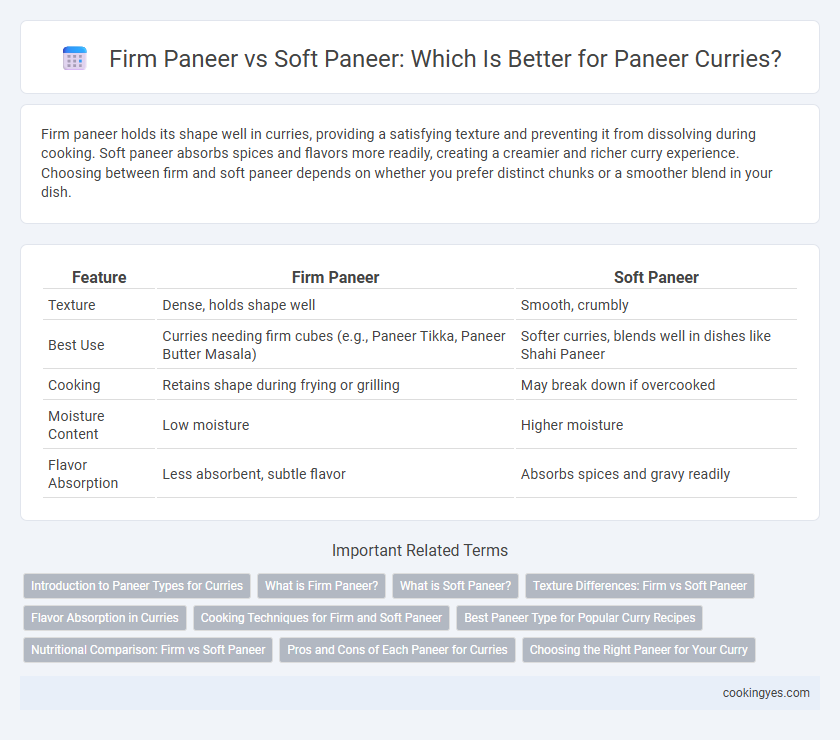Firm paneer holds its shape well in curries, providing a satisfying texture and preventing it from dissolving during cooking. Soft paneer absorbs spices and flavors more readily, creating a creamier and richer curry experience. Choosing between firm and soft paneer depends on whether you prefer distinct chunks or a smoother blend in your dish.
Table of Comparison
| Feature | Firm Paneer | Soft Paneer |
|---|---|---|
| Texture | Dense, holds shape well | Smooth, crumbly |
| Best Use | Curries needing firm cubes (e.g., Paneer Tikka, Paneer Butter Masala) | Softer curries, blends well in dishes like Shahi Paneer |
| Cooking | Retains shape during frying or grilling | May break down if overcooked |
| Moisture Content | Low moisture | Higher moisture |
| Flavor Absorption | Less absorbent, subtle flavor | Absorbs spices and gravy readily |
Introduction to Paneer Types for Curries
Firm paneer retains its shape and texture when cooked, making it ideal for grilling, frying, and robust curries that require the cheese to hold together without melting. Soft paneer has a creamier, tender consistency that blends well into rich, creamy sauces, adding a delicate texture ideal for mild, saucy dishes. Choosing the right paneer type enhances the curry's mouthfeel and flavor profile, ensuring the cheese complements the dish's cooking method and spice level.
What is Firm Paneer?
Firm paneer is a dense, non-crumbly Indian cheese that holds its shape well when cooked, making it ideal for gravies and stir-fries where intact cubes are desired. It is pressed and drained thoroughly to remove excess moisture, resulting in a texture that resists breaking down in hot curries such as Paneer Tikka Masala and Matar Paneer. Compared to soft paneer, firm paneer provides a robust bite and absorbs spices without disintegrating, enhancing the overall curry experience.
What is Soft Paneer?
Soft paneer is a fresh, delicate Indian cheese made by curdling milk with lemon juice or vinegar, resulting in a tender texture that easily absorbs spices and flavors in curries. Unlike firm paneer, which holds its shape when cooked, soft paneer breaks down slightly in dishes, creating a creamy consistency ideal for rich gravies and smooth sauces. This makes soft paneer perfect for creamy curries like Shahi Paneer or Malai Paneer, where a melt-in-the-mouth texture enhances the overall dish.
Texture Differences: Firm vs Soft Paneer
Firm paneer maintains its shape during cooking, making it ideal for grilled or fried dishes where sturdiness is essential. Soft paneer has a delicate, creamy texture that readily absorbs spices and flavors, perfect for rich, saucy curries. The texture difference affects cooking methods and dish outcomes, with firm paneer offering chewiness and soft paneer delivering a melt-in-mouth experience.
Flavor Absorption in Curries
Firm paneer holds its shape better in curries, allowing it to absorb rich spices and flavors without disintegrating, making it ideal for dishes like paneer tikka masala or matar paneer. Soft paneer, with its delicate texture, tends to soak up more gravy but can become mushy, which suits creamy curries such as paneer butter masala or shahi paneer. Choosing between firm and soft paneer impacts the curry's texture and the intensity of flavor infusion, enhancing the overall taste experience.
Cooking Techniques for Firm and Soft Paneer
Firm paneer holds its shape well in curries, making it ideal for frying or grilling before adding to dishes like Paneer Tikka or Matar Paneer, as it withstands rigorous cooking without disintegrating. Soft paneer is best suited for simmering gently in creamy, delicate sauces such as Shahi Paneer or Kadai Paneer, enhancing the dish's texture while absorbing spices effectively. Adjusting cooking times and temperatures ensures firm paneer retains a chewy bite, whereas soft paneer achieves a melt-in-the-mouth consistency.
Best Paneer Type for Popular Curry Recipes
Firm paneer retains its shape well and is ideal for curries like Paneer Tikka or Shahi Paneer, where distinct cubes are preferred, while soft paneer blends smoothly in dishes such as Palak Paneer or Paneer Butter Masala for a creamy texture. The protein content and moisture levels in firm paneer make it suitable for grilling and frying, enhancing flavor and texture. Soft paneer, with higher moisture, absorbs spices effectively, making it perfect for rich, smooth gravies in popular Indian curry recipes.
Nutritional Comparison: Firm vs Soft Paneer
Firm paneer contains slightly higher protein content and lower moisture levels compared to soft paneer, making it more suitable for curries that require paneer to hold shape during cooking. Soft paneer has higher moisture content, resulting in a creamier texture but slightly lower protein density and marginally increased fat content. Both types provide rich sources of calcium and casein protein, essential for muscle repair and bone health, with firm paneer often preferred for nutrient-dense dishes.
Pros and Cons of Each Paneer for Curries
Firm paneer holds its shape well during cooking, making it ideal for grilled or stir-fried curries where texture retention is crucial; however, it can be less absorbent of spices, leading to a milder flavor profile. Soft paneer absorbs curry spices more effectively, resulting in a richer taste, but it tends to break down easily in liquid-based dishes, potentially altering the curry's consistency. Choosing between firm and soft paneer depends on the desired texture and flavor intensity in the curry, balancing durability with seasoning absorption.
Choosing the Right Paneer for Your Curry
Firm paneer retains its shape and texture during cooking, making it ideal for dishes like tikka masala or grilled paneer skewers where cubes need to stay intact. Soft paneer absorbs spices and sauces more readily, creating a creamier, melt-in-the-mouth experience perfect for rich gravies like shahi paneer or matsaman paneer. Selecting firm or soft paneer depends on the desired texture and cooking method, ensuring the curry achieves the intended flavor and consistency.
Firm Paneer vs Soft Paneer for curries Infographic

 cookingyes.com
cookingyes.com